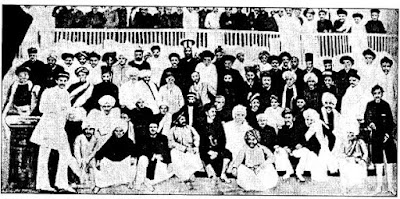A2Z
Motilal Nehru’s stature and wealth both were growing in leaps and bounds, so was his stature. He, though, had something rarely seen among others- his innate will of sharing his achievements, and even wealth with others. As Nanda points out, Motilal was not the only Indian lawyer doing well.
“What distinguished Motilal was not that he earned enormous sums of money: there were other lawyers in Allahabad - Sir Sunderlal for example - who did not earn less, and there werequite a few in Bombay and Calcutta who earned more. But only of Motilal could it perhaps be said that expenditure rose pari passu with income. He spent generously too.”
And he did not do so only for his own nuclear family which he indeed took very good care of. He also spent just as lavishly and lovingly for his dead brother Nand Lal’s family living with him too with no sign of discrimination between the two. He, in fact, financed the education of sons of both his brothers much before he set his own son Jawaharlal at the same path. On reaching Harrow, Jawaharlal Nehru was to find the comfort of being in the company of his elder cousins
Brijlal, son of his Nandlal, studying at Oxford, and Nashidhar’s son Shridhar at Cambridge. But we would reach there later.
Back home, increasingly rich and even more respected Motilal Nehru, awed by not only the members of the bar and mid level British gentry but also by the likes of the the Chief Justice Sir Grimwood Mears, spent just as lavishly on parties in the curated lawns of his house with the gentry of the whole city in attendance. In fact, the invitation to his parties was the new marker of who had arrived at the scene, and who had to wait like the ‘brief less barriasters’ a melancholic phrase much in vogue then.
The parties would be full of good ood, good wine and even better conversation not limited to the exploits in the court. Indian National Congress, founded in 1885 by, but not alone and himself, Allan Octavio Hume, would soon start gatecrashing these parties and become part of the conversations.
The histories of modern, Independent India and the Nehrus were finally all set to get entwined for good.
Time for a detour here. Even a cursory look at the history of colonial India makes one wonder if the Raj was a Kamikaze mission. It was the Raj, at least its officials, who often gave impetus to the movements and rebellions that grew into the collective, national struggle for independence. Take the foundation of Congress itself. It was expedited, if not entirely caused, by mainly three events. First was Lord Lytton’s 1877 Imperial Assemblage at Delhi with its wasteful extravaganza in the middle of The Great Famine of 1876–1878 that killed at least 5.5 million Indians. It was an event that every single Indian took umbrage to. In a way, this event made a first shot at uniting Indians after the failed Great Mutiny of 1857 which was mainly centred in North India with small pockets of exception in Bengal, Tripura the then Orissa (now Odisha) and some parts of the British Empire like the Straight Settlements and in Trinidad.
The second was the Raj’s indifference to the growing disaffection among those Indians which had taken its promises of liberalism at face value and thought that it was the Indian Administration which was torpedoing the reforms. This forced wealthy Indians settled in various parts of the Empire to start organising themselves. East India Association founded in London by Dadabhai Naoroji, whom Mahatma Gandhi himself called the Father of the (Indian) Nation in 1866.
Such organisations were the first to build the undiluted Indian identity over and above all others- caste to class. They were also to provide Indian aspirations platforms for organization and launch pads for solidarity movements across the world. They were also to give a model to Indian National Congress. Incidentally, Naoroji himself attended the first Indian National Congress. He would also become its president in 1893 while being a sitting member of the House of Commons.
Third was the innocuous looking Elbert Bill of 1883- allowing Indian Judges to preside over the trails of the British. This time it caused what was called “White Backlash” and gave Indians yet another reason to join hands. Allan Hume, a Scot, a liberal radical, an associate of the theosophists took upon himself the cause of undoing such injustice. He was quite a good candidate too, not chained to any identity- castes or religious. 72 delegates attended that Congress in 1985. Having come up with his Drain Theory convincing freedom fighters across the world, Naoroji was one of them. The Congress had started meeting every year in different cities. It was attracting all the new elite- the aspirational and successful Indians grown up with English education and the values it spoke about.
Motilal Nehru was to be no exception. Neither were others. But this is a story of Nehrus in the centre, not Congress. Though, as I said, the histories of all three- Nehrus, Congress and Country would be soon inseparable.
It was in one such party in which young Jawaharlal got horrified to see guests drinking blood. He had started identifying whiskey by colour, but had never seen red wine yet.

Comments
Post a Comment